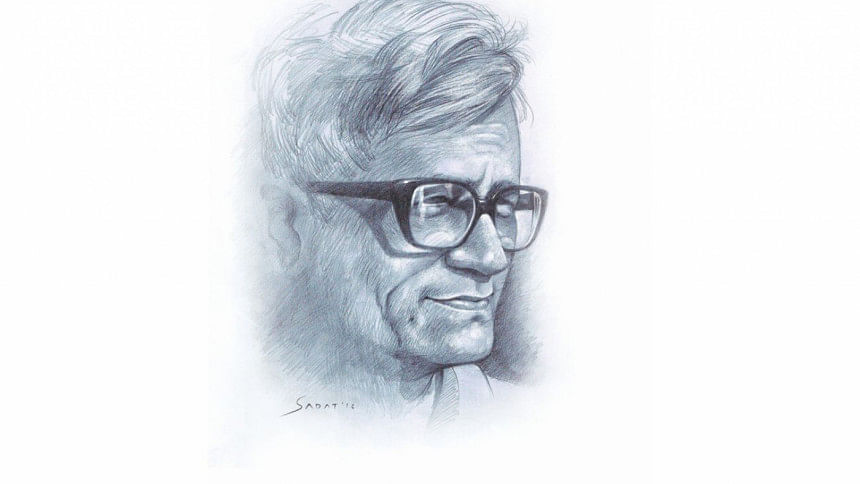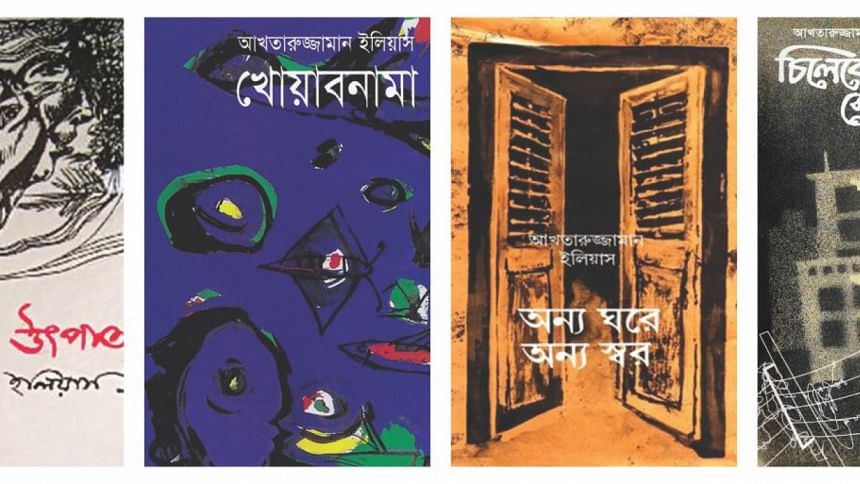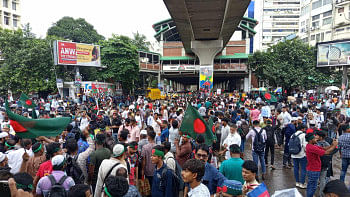Elias writer of the oppressed

Akhtaruzzaman Elias is difficult and ambiguous. His language is turgid and his narrative tortuous. His characters spout dirty, uncivilised curses. The world he depicts is clouded and gloomy, and the characters he employs suffocate under its dark weight. His long, meandering sentences do not offer any help either. In short, his prose does not bring any relief to readers; it rather drives away even those who are into serious fiction, leave alone those who seek pleasure or some solace through the act of reading.
But ask any critic or writer and you'll understand the reverence he is shown and the position he is given in Bangla literature. Mahasweta Devi, Shawkat Ali, Hasan Azizul Haque, Shankha Ghose, Serajul Islam Choudhury -- the list of master writers who think Elias is the greatest Bangali novelist of all time could go on and on. His influence upon younger generations is another case in point. Would it be an exaggeration to say he became almost a cult figure among young writers in the late 1990s and early 2000s? I personally know a few who are still under the spell of his forceful, long sentences and who still have difficulty finding their own style.
What are we to make of it? Why is someone, who does not have a prominent place in mainstream literature, so highly regarded by most writers and a lot of readers as well?
I begin with this question as, I believe, it is central to understanding Elias and the revolution he's brought about in Bangla prose fiction.

That Elias was capable of writing lucid, lively prose can be seen in many of his short stories, for instance, in Khonari. Sparks of that fluidity are evident aplenty in his novels too. His lucidity, in fact, is unique in that it is imbued, almost inherently, with ingenious analogies in a way that one needs to take an imaginative leap to fathom its full potential. Take, for example, his description of Katlahaar Bil, that vast lake in Khoabnama, wherein the shadow -- cast on the water by the wings of the white egrets nesting in a pakurh tree -- assumes life. Or the description of Tamiz's rice fields which become animated every now and then, changing colours, as if in sync with his rising and falling emotions regarding his share in the production. The crops at times cry as Tamiz worries about his share. He is a sharecropper in the time of Tebhaga Andolon (a farmers' movement to realise two thirds of the crops from the landlords in Bengal) during the tumultuous days of partition. Instances of such fluid and impassioned description of rice fields are unparalleled in Bangla literature.
Elias, nonetheless, consciously deviates from lucidity and switches to other modes of narration. Because his is a fictional world that the Russian formalist critic, Mikhail Bakhtin, would call "heteroglossia", where a heterogeneous cast of people come together to form a variegated world of conflicting intersectionalities; where people from the lower castes or classes are not sent into the backstage, to be dragged in front of the audience only as extras; where their angst, frustrations and voices are given as much prominence as the cheap sentimentality of a middle-class hero or heroine. Just one (descriptive) narrative mode in the standard language, hence, falls short of containing the multiplicity of conflicting voices and competing narrative forms of a heteroglossia. A standard narrative mode, furthermore, runs the risk of being "monologic", of being prone to define and appropriate the lower classes in a language that they do not consider their own. Faced with such difficulties, an author, who is consciously putting on stage lower class men and women on an equal footing with landlords, would inevitably adopt a "dialogic" narrative that assigns equal space to all characters and all narrative forms including the descriptive ones.
The use of a myth in Khoabnama becomes the battle ground for warring ideologies, all the dimensions of which can only fit in a dialogic framework. A little reflection on the storyline, I believe, will explain the matter itself.
In Khoabnama, the myth about the Katlahhar Bil is entwined deeply in the ideologies of farmers, fishermen, blacksmiths and potters. According to the myth, the ghost of a soldier named Munshi rules the lives of people living around the lake. It is believed that Munshi, whose ghost has settled in a giant pakurh tree by the lake, was martyred in a battle with the East India Company. He was a courageous soldier under the joint leadership of Fakir Maznu Shah and Bhabani Pathak. The lower class Muslims and Hindus subscribe to the non-communal version of this myth: Maznu, a Muslim ideologue, and Bhabani, a Hindu saint, became friends and fought together to oust the British colonisers.
But this non-communal myth is split in several other versions. The Hindu elites believe a Hindu goddess had created this lake whose sanctity can be protected only if the Hindu untouchables and the poor, uncultured Muslims are kept away from its water. Then the emerging Muslim class, represented by Sharafat Mandal and his sons, offers its own version. Although Sharafat is okay with Maznu and his Munshi, he does not care much about Bhabani and the anti-communal spirit.
The three different versions show competing ideologies at work. Days of the Hindu zamindars were numbered as the partition politics was gaining momentum. At a national level, Muslim league leaders were stoking the communal flames not to bring about any radical social change, but to replace the Hindu zamindars and to gain control over the land and industries. The Muslim landlord Sharafat, much like the Hindu zamindar, takes away more than two-thirds of the crops from sharecroppers like Tamiz. What the Congress was doing, too, had very little significance for the interests of farmers and other marginal classes.
The myth's anti-hegemonic potential among the lower classes is immense. So, the catastrophic moment comes when, inspired by news of the Tebhaga movement in Rajshahi, Hindu and Muslim farmers and fishermen and potters are enthused to wage a movement against Sharafat.
But Elias shows how this simmering anti-communal mass farmers' movement was co-opted by Muslim League leaders. Similarly, in Chilekothar Sepai, which flits between two parallel narratives -- one in a village where farmers rebel against landlords and the other in Dhaka where the mass uprising of 1969 is taking place -- he shows how the mass uprising, falling into the hands of national leaders, turned into a nationalist movement that made grounds for capitalism to grow unbridled, pushing farmers, workers and other underprivileged groups to the margins, leaving them on their own, burying their contribution to the economy and the national movements virtually into oblivion.
Elias's excellence in dialogic narratives clearly speaks of his political consciousness as a writer. But in my opinion, this is not where he started a revolution. This was done by many before and after him.
Bringing suppressed voices to the fore in a dialogic framework is a break from mainstream fiction that Manik, Tarashangkar and Bibhutibhushon had initiated in the 1930s; but bringing out their voices in their own language, in dialects to be precise, was a later development which in this part of the Bengal owes most, among others, to Hasan Azizul Haque, Shawkat Ali and Selina Hossain. Among the younger generations are Kayes Ahmed, Manju Sarkar, Shahidul Zahir, Shushanto Majumdar, Harishankar Jaladas and Prasanta Mridha.
Hasan's use of dialect, not only in dialogues but also in the act of narration, is remarkable. However, Hasan and the others above shed light on their men and women from the outside. In Jibon Ghose Agun, Hasan's most towering achievement in allegorising the class struggle of lower caste people, one cannot but notice an objectivity marked by external observation. None of the characters in it have a life or thought of their own, defined and seen as they are through an objective lens that makes them, at best, representatives of their class or caste.
Conversely, Elias sheds light on his characters from the inside. True he introduces them, puts them in context, but he does not tell their stories. The characters themselves bear the burden of telling their own stories through dreams, daydreams, myths and desires. Under the garb of objectivity, Elias's narrator disappears from the locus of the novel and all that is left are the men and women themselves. Their dreams and desires and ability or inability to compromise with the material conditions of life are then narrated in a language that blurs the boundaries between standard and non-standard language, between dreams and realities. Elias merely assumes the role of a moderator, passing on the mantle of narration, threading it between events. Even the Tebhaga movement or the watershed event of partition is not stated objectively but is always seen through the eyes of the characters.
From the very beginning of his writing career, Elias's fiction marked a departure from mainstream literature. Literature, Elias knew, is a purely middle class affair, its production and consumption being dominated mostly by middle class taste, and to some extent, by an elite class professing stylistic purity and thematic universality. Cheap sentimentality of heroines and idealised versions of heroes ready to die for love or for the country are what saturate a capitalist market like ours. Then there are those (humanist) tales of universal values and traits such as love, altruism etc. One common consequence of these tendencies is to look away from the inequality and the real struggles arising out of the material conditions of a given time, and to insist, instead, on fixing the gaze on subjects ranging from love to sex to feelings of humanity. At an ideological level, both of these tendencies resolve their differences by taking a leap into the mould of a nationalist discourse, that all-powerful discourse which promises equality and ensures inequality at the same time.
As a true Marxist, Elias refused to turn a blind eye on the dialectical forces of history. So he banished sentimentality and idealisation from his stories altogether. There are no sentimental or idealised characters in his whole oeuvre. Whether they come from the stinking gutters or from a higher society, his characters are raw in the articulation of their desires and grievances. This is precisely why he has been mistakenly labelled as a "realist" by many who cannot see beyond the surface. If realism or a realistic mode of narration was what he wanted to achieve, he might as well have taken the path of Hasan and Shawkat. But he didn't.
Elias carved his own narrative style which disrupts realism and scientific observation but embraces the incoherence of dreams and memories and illusions. Chilekothar Sepai begins with an illusion of Osman that cuts through to the end and Khoabnama with a myth about the Katlahaar Bil through the sleepwalking slurs of Tamiz's father. To some these incoherent lapses have made his narrative more inaccessible whereas the truth is: they have actually made his fiction a place for the subalterns who can appear in it in their own terms and speak their own language, spout curses at will, without being filtered through or appropriated by a scientific or nationalist or capitalist discourse. In his fiction, the subaltern, like Khizir in Chilekothar Sepai, and the subaltern of the subaltern, like Kulsum in Khoabnama, do and can speak. And this is exactly where he staged the revolution.
His long, complex sentences are an approximation of the way rural people relate stories of the past by prolonging a sentence with repetition of certain expressions. In Khoabnama, while describing the rootedness of a Hindu character who is about to be uprooted by widespread (manufactured) communal hatred, there's this repeated reference to his forefathers, beginning each time with the father and then going back to the grandfather to the great grandfather to the grandfather of the great grandfathers. This reference, in much the same way, would be as frequently used to describe Tamiz's father when his habit of catching fish in the common property of Katlahar Bil is thwarted by Sharafat Mandal, the Muslim landlord who, by leasing the lake from the deputy of the zamindar, has turned it into private property.
Put in context, one can easily see that this basically is a conversational way of relating the past among rural people and that Elias is not teasing readers or testing their patience with repetitive use of such references. He is rather taking his narration closer to the conversational style of the oppressed. These conversational styles, handed down from generation to generation, stay far outside the modern, capitalist discourses. Elias has consciously brought them to the fore, making them integral to his narrative, so that the collective memories and desires of the oppressed could not be pushed to the precipice, as it was done by the nationalist movements; so that the oppressed could stay near the centre, if not in the larger society, then, at least, in the realm of fiction.
Rifat Munim is a journalist and writer.

 For all latest news, follow The Daily Star's Google News channel.
For all latest news, follow The Daily Star's Google News channel. 



Comments